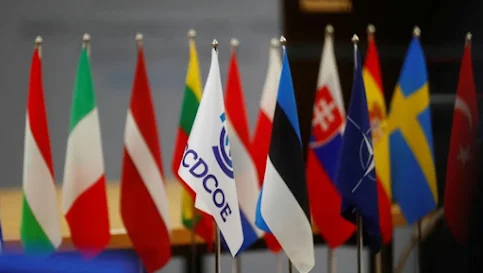 |
| NATO Cooperative Cyber Defence Centre of Excellence, Estonian and NATO flags are seen in front of member countries flags at the building premises in Tallinn, Estonia November 29, 2017 |
International Military South Korea became the first Asian country to join the NATO cyber group. On Thursday, China announced the merger of its domestic intelligence with the NATO cyber defense group.
This is reportedly sourced from South Korea's National Intelligence Service (NIS). The NIS is officially admitted to the NATO Cooperative Cyber Defense Center of Excellence (CCDCOE) based in Tallinn, Estonia.
With Seoul's recognition, the group's number of members has now increased to 32, including 27 NATO members. "We plan to strengthen our cyber response capabilities to a world-class level by increasing the number of our staff deployed to the center and expanding the scope of joint training," said NIS, quoted from aa.com.tr.
A cyber-defense group was founded in Tallinn in 2008 in response to a cyberattack that disrupted the Estonian state network. Their focus includes research, training, and cybersecurity drills.
Reporting from the Eurasian Times, this did not go unnoticed by the Chinese. In response to the news, Hu Xijin, former editor of state-owned media China Global Times, tweeted. He thought that the action was a provocation and could lead to an Asian war.
"If South Korea takes the path of antagonizing its neighbors, the end of this path will be Ukraine," he said. According to the Eurasian Times, NATO also invited four of the United States' Asian allies, including South Korea, to attend the NATO foreign ministers' conference in Brussels in April 2022.
The meeting is known to aim to discuss the situation in Ukraine. The four countries have been invited to attend the upcoming NATO summit in Madrid, in June. So, is South Korea a member of NATO?
Reporting from an article published in 2010 by eastwest.ngo, NATO is known to have special partners referred to as "contact countries" or "other partners". They "share the same strategic concerns and core values of the Alliance", according to NATO.
According to nato.int, NATO has nine "partners around the world" or "global partners", who work with alliances individually. NATO's global partners include Afghanistan, Australia, Colombia, Iraq, Japan, Republic of Korea, Mongolia, New Zealand and Pakistan.
NATO engagement with global partners is increasingly important in a complex security environment, where many of the challenges facing the Alliance are global and no longer bound by geography.
So, what is NATO's role in Asia and more specifically East Asia? It is difficult to avoid the current conclusion that NATO remains the main determinant of the military power balance in East Asia.
This does not mean that all European NATO members will automatically engage in fighting in Korea if that country goes to war.
As an example, if that happened, then the United States and South Korean troops would easily defeat the conventional North Korean troops. However, this relationship means that European NATO leaders with an interest in Korean security must now review where exactly they stand.
Even so, the close relationship between South Korea and NATO inevitably received criticism from within the country. Quoted from the National Interest, Yang Jiechi, a member of the Political Bureau of the Central Committee of the Chinese Communist Party, visited South Korea's Director of National Security Suh Hoon on August 22, 2020.
He stated that South Korea should 'not stand on the side of the US'. Yang insists that peaceful relations between China and the United States are essential to security in Northeast Asia. South Korea is a democracy with values and interests largely aligned with the United States.
However, South Korea's position is relatively more vulnerable in relation to China.
